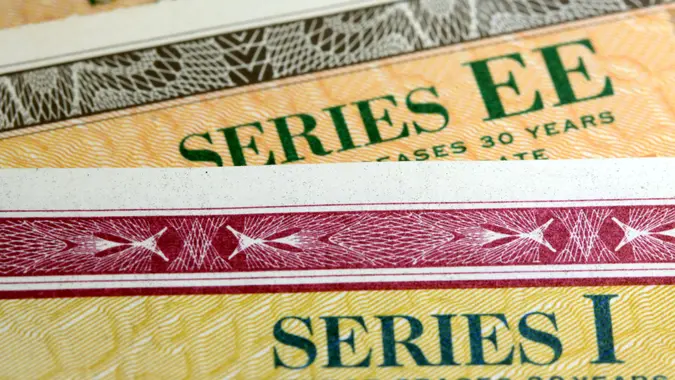How Do Savings Bonds Work? Your Guide

Commitment to Our Readers
GOBankingRates' editorial team is committed to bringing you unbiased reviews and information. We use data-driven methodologies to evaluate financial products and services - our reviews and ratings are not influenced by advertisers. You can read more about our editorial guidelines and our products and services review methodology.

20 Years
Helping You Live Richer

Reviewed
by Experts

Trusted by
Millions of Readers
Investing can be an overwhelming, possibly scary notion. If you want to set some money aside — and do so safely — you might not realize you have more options than just a standard savings or CD account. Savings bonds might not be the flashiest investing option, but they are consistent, which in today’s economy, isn’t nothing.
What Is a Savings Bond?
A savings bond is an investment instrument offered by the federal government through financial institutions. When you buy a savings bond, you loan money to the U.S. government in exchange for a return at a future date.
Essentially, savings bonds are debt securities that fund U.S. government spending. They are considered one of the safest investments, because they are guaranteed by the federal government, as you are technically loaning money directly to the government and then receiving a return on your investment through interest earned.
Savings Bonds Key Takeaways
Savings bonds are available in small denominations, with a face value between $25 and $10,000. Face value, also known as par value, is the amount that will be paid when the bond matures, or comes due. Key features of bonds include, but are not limited to the following:
- Interest: Bonds offer interest payments at a nominal rate.
- Taxes: Interest is taxable, but it is deferred until you cash the bond or it has reached its maturity date. They are not subject to state or local taxes, only federal taxes.
- Transferability: You can transfer bonds to another person at no charge as soon as five days after purchasing them.
- Age Requirements: Minors can hold bonds in their own names.
- Payroll Savings Plan: With a payroll savings account plan, you can deposit part of your paycheck directly to your Treasury account to automatically purchase savings bonds.
How Savings Bonds Work
The purchase price of savings bonds is the same as their face value. You pay $100 for a $100 savings bond, but the value of the bond increases over time.
Savings bonds come in two versions: Series EE and Series I.
- Series EE: These bonds have a fixed interest rate for the life of the bond.
- Series I: These bonds earn interest at a composite rate that can change semi-annually.
Series EE and Series I savings bonds earn interest for 30 years. The interest is added to the bond each month and compounds semi-annually.
Interest Earned on a Bond
Say, for example, you buy a Series EE bond for $100 that earns 0.10% interest per year. One month’s worth of interest is added to the $100 principal amount each month.
After six months, the bond is worth $100.05. It earns interest on this principal amount for the next six months, after which the interest compounds again.
How To Buy Bonds
To purchase a bond, you need a TreasuryDirect account, which also allows you to manage your bonds at your convenience. To find out exactly what your bonds are worth — or could be worth — check out the Savings Bond Calculator at TreasuryDirect.
Types of Savings Bonds
Two types of savings bonds are available: Series EE bonds, which are traditional savings bonds, and Series I bonds, which carry an inflation-adjustment component.
Series EE U.S. Bond
You purchase Series EE savings bonds at face value, but the Treasury Department guarantees that the bonds will at least double in value after 20 years. These bonds continue to earn interest after that period, for up to 30 years in total.
Here are more details about Series EE savings bonds:
- Face value: Minimum of $25, available in penny increments
- Maximum available for purchase: $10,000
- Interest terms: 2.50% annual fixed-rate for bonds purchased between May 2023 and October 2023
- Holding period: Up to 30 years; no penalty for cashing bonds after 5 years
Series I U.S. Bond
Series I bonds are similar to Series EE bonds but are affected by both a fixed rate and an inflation rate.
- Face value: Minimum of $25, available in penny increments
- Maximum available for purchase: $10,000
- Interest terms: 4.30% composite rate for bonds purchased between May 2023 and October 2023
- Holding period: Up to 30 years; no penalty for cashing bonds after 5 years
How To Cash in Bonds
You can cash in savings bonds at your local bank or through the U.S. Department of the Treasury. Here are two ways to cash them:
- Paper Bonds: Present the bond and an acceptable form of identification to a bank. If you’re a beneficiary cashing the bond of a deceased person, you will also need a certified death certificate. Alternatively, you can complete FS Form 1522 and sign it at a bank for signature verification. Mail the form along with the unsigned bond to the U.S. Department of the Treasury.
- Electronic Savings Bonds: Log in to TreasuryDirect. Follow the onscreen steps for cashing a bond.
Are Savings Bonds a Good Investment?
A savings bond’s security — the financial backing of the U.S. government — can be attractive to a cautious investor. These bonds do increase in value over time, and they remain popular as gifts. As with any investment, research your options and choose the one that best fits your financial goals. Even so, they may not be the best choice for all situations, so consider these pros and cons:
Pros of Savings Bonds
- Low risk
- Guaranteed returns
- Protections against inflation
Cons of Savings Bonds
- Minimal returns
- Slow growth
Final Take To GO
Though savings bonds are low risk, they can also feel like a low reward. However, any savings that earns interest is a good savings, and there is comfort in guaranteed returns. These can make a good slow-growth investment or gift for a child in their name to set up their first savings.
FAQ
Here are the answers to a few common questions about savings bonds.- How long does it take for a $100 savings bond to mature?
- These government-backed bonds take 30 years to reach maturity.
- How much is a $200 savings bond worth after 20 years?
- While the value of a $200 bond depends on the interest rate and whether it is a Series EE or Series I bond, you won't lose money on a savings bond – the minimum value after 20 years will be $200, and it should be worth more due to the interest.
- How long does it take a $200 savings bond to mature?
- While bonds reach their full maturity after 30 years, Series EE bonds are guaranteed to have doubled in value after 20 years.
Caitlyn Moorhead contributed to the reporting for this article.
Our in-house research team and on-site financial experts work together to create content that’s accurate, impartial, and up to date. We fact-check every single statistic, quote and fact using trusted primary resources to make sure the information we provide is correct. You can learn more about GOBankingRates’ processes and standards in our editorial policy.
- Investor.gov. "Savings Bonds."
- CNN Money. "What Are the Advantages of Bonds for Retirement?"
- U.S. Bank. "Are Savings Bonds Still a Thing?"
 Written by
Written by  Edited by
Edited by 

























